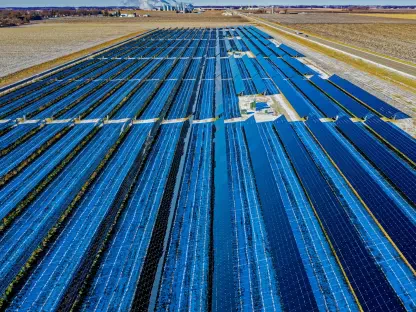In a significant move towards a cleaner energy future, the North Carolina Utilities Commission (NCUC) has approved an ambitious integrated resource plan (IRP) for Duke Energy Progress and Duke Energy Carolinas. This plan, proposed in August, aims to balance energy reliability with substantial carbon emission reductions. This comprehensive strategy results from a July settlement agreement involving Duke Energy, NCUC Public Staff, Walmart, and the Carolinas Clean Energy Business Association. Notably, a key aspect of this agreement is the delayed timeline for achieving a 70% reduction in carbon emissions from 2005 levels by 2030, a target mandated by a 2021 state law.
Comprehensive Energy Strategy
Diverse Energy Portfolio
The approved plan includes a diverse mix of energy sources, reflecting a strategic approach to North Carolina’s energy needs. Duke Energy plans to construct 3,460 MW of new solar generation and at least 625 MW of battery energy storage paired with solar by 2031. Additionally, the plan includes securing 1,100 MW of battery storage and 1,834 MW of pumped storage hydropower. These initiatives are designed to enhance the state’s renewable energy capacity and storage capabilities. By expanding solar energy production and integrating advanced storage solutions, the plan aims to provide a stable and sustainable power supply.
Battery storage paired with solar energy is particularly essential as it allows for the capture and use of energy generated during sunny periods for use during peak demand times. Pumped storage hydropower, which involves storing energy in the form of water pumped to a higher elevation, also plays a vital role in energy storage. This stored energy can be released to generate electricity when needed, serving as a significant backup to intermittent renewable sources like solar and wind. The combination of these technologies ensures that renewable energy can be more reliably integrated into the grid, supporting North Carolina’s transition to a greener energy portfolio.
Advanced Nuclear and Offshore Wind
Duke Energy is also focusing on advanced nuclear generation and offshore wind projects as part of its comprehensive energy strategy. The plan outlines the operationalization of 600 MW of advanced nuclear generation by 2035 and explores the feasibility of 2,400 MW of offshore wind with a view to commercial operation by the same year. These projects are expected to play a crucial role in achieving long-term sustainability and energy security. Advanced nuclear technologies promise to deliver high-capacity, low-carbon electricity, essential for meeting future energy demands sustainably.
Offshore wind, although more complex and costly to develop, offers substantial benefits, including higher and more consistent wind speeds compared to onshore sites. This consistency makes offshore wind a reliable source of renewable energy capable of generating significant amounts of electricity. The commitment to exploring and potentially developing offshore wind projects signifies Duke Energy’s willingness to invest in innovative and less conventional renewable energy technologies. Together, advanced nuclear and offshore wind projects will help diversify the energy portfolio and support the goal of substantial carbon emission reductions.
Transition from Coal to Cleaner Alternatives
Phased Retirement of Coal-Fired Units
A significant component of the plan is the phased retirement of Duke Energy’s remaining coal-fired units, totaling over 8,000 MW, by 2036. This move is aimed at reducing the state’s reliance on coal and lowering carbon emissions. The retirement of these units will be complemented by the development of new natural gas-fired plants, which are seen as a transitional energy source. Natural gas plants, while still emitting carbon, produce significantly less than coal-fired units, providing a cleaner alternative during the transition.
By phasing out coal and incorporating cleaner alternatives, the plan aims to address environmental concerns while ensuring a stable energy supply. Natural gas plants are quicker and less expensive to build compared to other renewable sources, providing a crucial bridge as infrastructure for renewable energy projects is developed and scaled up. Thus, the strategy to retire coal-fired units incrementally and replace them with natural gas and other cleaner alternatives underscores a practical pathway towards achieving emission reduction targets.
Competitive Solar Procurements
To further boost solar energy capacity, Duke Energy will hold two competitive solar procurements between 2025 and 2026. These procurements aim to achieve 3,460 MW of new controllable solar generation by 2031. This initiative underscores the company’s commitment to expanding its renewable energy portfolio and reducing its carbon footprint. Competitive procurements are designed to attract a range of suppliers and technologies, potentially driving down costs and fostering innovation within the solar energy market.
Expanding solar generation capacity through these competitive processes is also expected to stimulate local economic growth by creating jobs and promoting investments in renewable energy infrastructure. This approach not only addresses environmental goals but also supports broader economic objectives. The increased solar capacity will further move North Carolina toward a more sustainable energy model, reducing dependence on fossil fuels and establishing a more resilient energy system.
Balancing Reliability and Clean Energy
Natural Gas as a Transitional Energy Source
Despite the focus on renewable energy, the plan includes the development of 900 MW of new natural gas-fired combustion turbine generation by 2030 and 2,720 MW of new natural gas-fired combined cycle generation by 2031. This approach is intended to ensure energy reliability during the transition to cleaner energy sources. Duke Energy will also develop 300 MW of advanced nuclear generation by 2034 and another 300 MW by 2035. These measures aim to balance the immediate need for reliable power with long-term sustainability goals.
Natural gas, regarded as a transitional energy source, provides the necessary backup to intermittent renewable sources. The inclusion of advanced nuclear generation further enhances this balance by contributing a steady and substantial supply of low-carbon energy. By investing in both current and future technologies, Duke aims to create a diversified energy portfolio capable of meeting varied demand scenarios, emphasizing a holistic and realistic approach to the energy transition.
Economic Growth and Environmental Responsibility
Duke Energy perceives the NCUC’s order as constructive, emphasizing the importance of a comprehensive approach to long-term resource planning. The directives support significant economic growth within the region while transitioning to a greener energy infrastructure. This balance between economic viability and environmental objectives is crucial for the state’s sustainable development. By adopting this strategy, Duke Energy ensures that the transition to cleaner energy supports the regional economy and job market.
The plan’s potential to attract investments, foster innovation, and create jobs underscores its alignment with broader economic goals. These aspects are particularly significant in a post-pandemic context, where economic recovery and sustainability are paramount. The strategy acknowledges the interdependence of environmental health, economic growth, and societal well-being, striving to harmonize these elements within North Carolina’s energy transition.
Criticisms and Challenges
Concerns from Environmental Groups
Despite broad approval, some dissenting voices highlight potential shortcomings in the plan. The Southern Environmental Law Center (SELC) contends that Duke is underestimating the grid’s capacity to integrate more solar, wind, and battery storage. Critics argue that the approved plan will burden communities with more expensive, polluting power plants while underinvesting in necessary clean and reliable energy resources. These concerns suggest that, while the plan is a step forward, it may not fully capitalize on the potential of renewable energy technologies.
Environmental advocates call for a more aggressive timeline and greater reliance on renewable sources to meet carbon reduction targets. The criticism underscores a tension between the urgent need to address climate change and the practical challenges of transitioning large-scale energy systems. Critics argue that the existing infrastructure and market dynamics could support a more rapid increase in renewable energy adoption, potentially reducing reliance on natural gas.
Achieving Carbon Reduction Targets
The Environmental Defense Fund (EDF) believes that North Carolina can still achieve the 70% carbon reduction target by 2032, even with the introduction of new gas resources. This perspective suggests that the state can balance the need for energy reliability with the urgency of reducing carbon emissions. However, achieving these targets will require continuous efforts and adjustments to the plan. The evolving nature of technology and market conditions necessitates flexible planning and iterative improvements.
Ongoing stakeholder engagement, regular assessment of progress, and adaptation of strategies will be essential to stay on track. Monitoring and incorporating technological advancements in renewable energy, storage solutions, and grid management can help optimize the plan’s implementation. Achieving carbon reduction goals hinges on this dynamic and responsive approach, ensuring that environmental and reliability objectives are consistently met.
Future Developments
South Carolina’s Deliberations
A significant development awaiting attention includes the deliberations of the Public Service Commission of South Carolina on Duke Energy’s resource plan for the Carolinas, with a decision expected by November 26. Following this, Duke plans to commence the immediate execution of the plan while refining the necessary modeling for their 2025 plan update, due by September 2025. This decision will influence the regional strategy and potentially drive further adjustments to the plan.
The outcomes from South Carolina’s deliberations may also provide insights or collaborative opportunities to align energy strategies across state lines. This regional coherence can bolster the overall effectiveness and efficiency of transitioning to a more sustainable energy landscape. It exemplifies the importance of cross-jurisdictional coordination in achieving comprehensive energy reforms.
Long-Term Vision
The North Carolina Utilities Commission (NCUC) has taken a substantial step towards a sustainable energy future by approving an ambitious integrated resource plan (IRP) for Duke Energy Progress and Duke Energy Carolinas. This plan, introduced in August, seeks to balance maintaining reliable energy supply with significant reductions in carbon emissions. The comprehensive approach emerged from a settlement in July, involving Duke Energy, NCUC Public Staff, Walmart, and the Carolinas Clean Energy Business Association. A crucial element of this agreement includes a delay in the timeline for achieving a 70% reduction in carbon emissions from 2005 levels, a target originally set for 2030 by a 2021 state law. This delay allows for a more gradual transition, ensuring energy reliability and economic feasibility as the region moves towards a cleaner energy landscape. The approved IRP underscores the commitment of these stakeholders to foster a future where lower emissions and reliable energy coexist.









